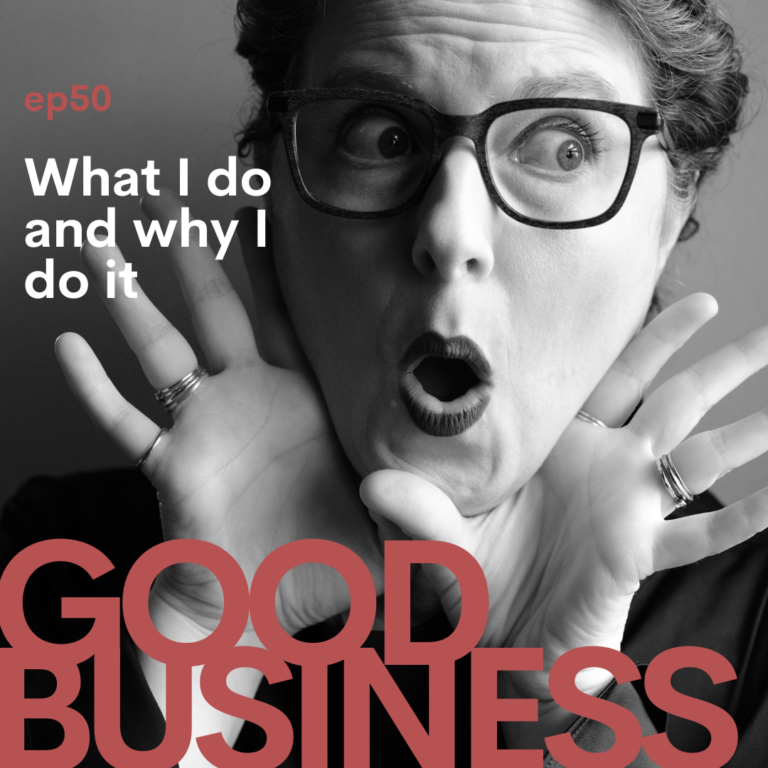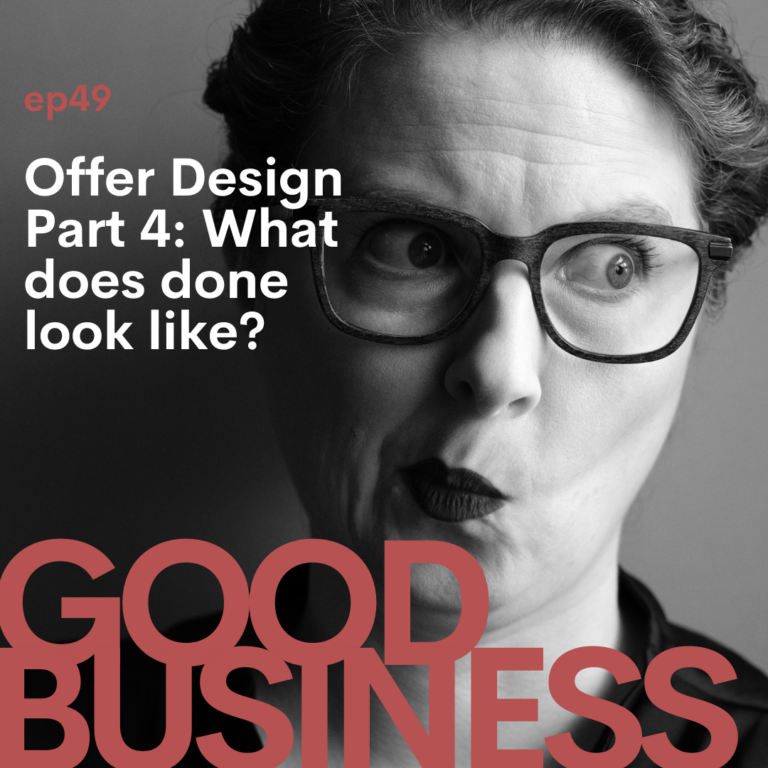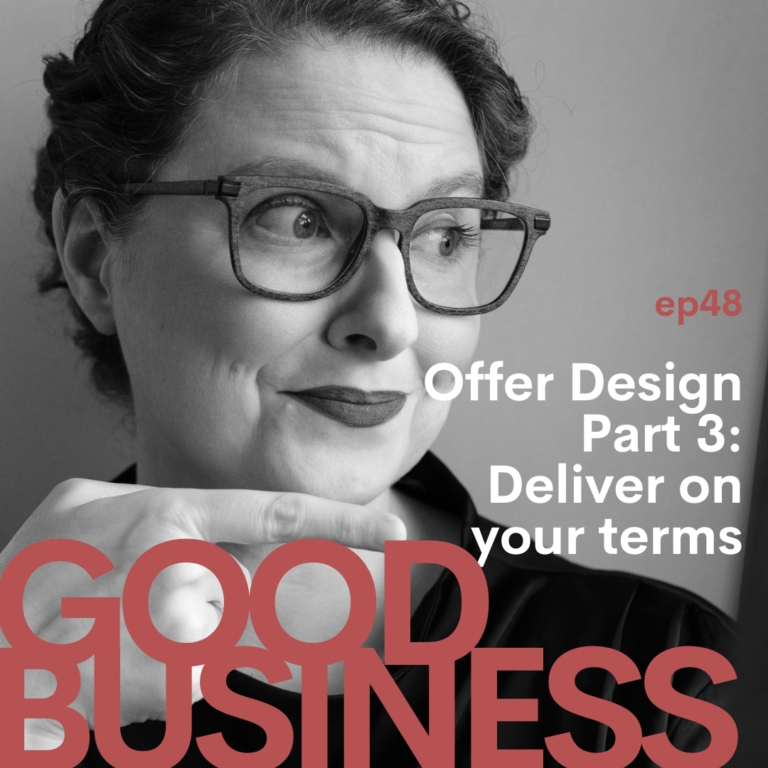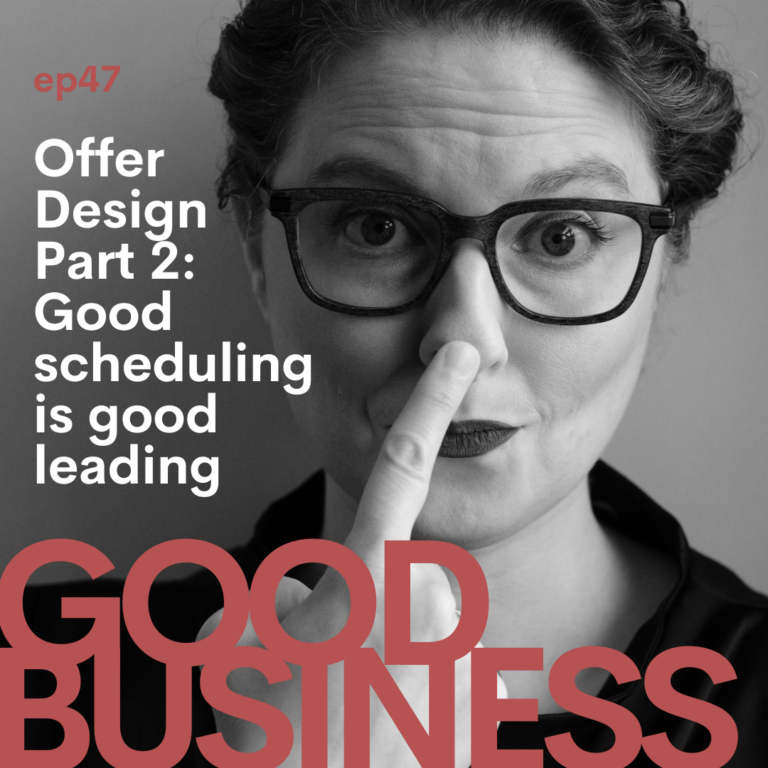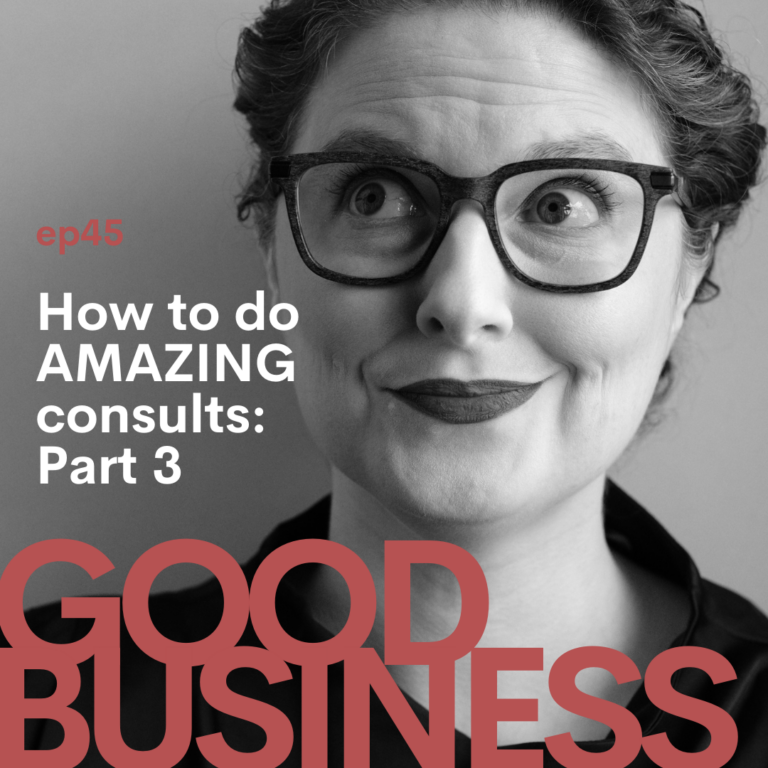In this episode, we talk about what productive antithetical marketing can look like, what it isn’t, and what any of this has to do with toilet paper.
Episode Transcript:
Hi everybody, and welcome back to the Good Business Podcast. I’m Illana Burk, your host, and welcome back to our ongoing series about leadership, power, and how all of those things play together for small business owners and those who are looking to run businesses ethically.
In the past several episodes, we’ve talked a lot about what leadership is, what your values are, how you think about those things, the tools that you need in order to deploy, to gain power, in this world, how to get comfortable with power and the like. I’m sure you can find the archive section if you haven’t already, if you’d like to catch up.
Today, we are beginning the conversation about how you express those things out into the world. So, the topic at hand today is antithetical stances in marketing and what it is, what it should be, what it shouldn’t be and what it can be.
So, first off, what is it? What is the idea of antithetical marketing? It’s common in rebellious type of brands. You know, the types of brands like me, like many of my listeners here, and it’s basically, when whatever the popular theme is, whatever the, whatever everybody’s doing, you basically take the stance that’s in the opposite direction. It’s pushback marketing. It’s everybody’s over there, so I’m going over here. Everybody’s doing this, so I’m going to do the opposite. The popular themes or ideas are this, so I’m going to go do that, right.
It’s basically, as a marketing strategy, taking up arms against, as a matter of, of strategy in tactics. It can be extremely effective. But it can also be extremely detrimental if not done well. So that’s kind of what we’re going to talk about. That’s the basic primer of what is it. It’s rebellion marketing.
Now, it’s born out of, usually something good. You know, a lot of people use antithetical marketing very productively, where you’re poking holes in something that needs holes poked in it. It’s pointing out that, hey, maybe that thing that’s really popular isn’t all it’s cracked up to be. Maybe you should question more. Maybe you should poke your own holes in something. Maybe you should examine a little closer before you jump on a bandwagon.
But, it’s kind of gotten co-opted as the bandwagon, right? We are in cancel culture now. So that means antithetical marketing of saying, whatever you do, don’t go like that thing over there for this reason that I’ve told you is important, has now become just marketing, right? It’s all about, we are different than the other guy.
Differentiation and antithesis are not the same. Differentiating can be done in a very positive way, in a very joinee way, right? It can be done in a way that articulates the benefits of something. Antithetical marketing is by and large just this is better than whatever that thing is.
So if that’s not true and you’re using antithesis in your messaging as a strategy for differentiation, then you’re very likely missing out on the opportunity to actually express benefits and express change. So that’s what we’re going to talk about, like what productive antithetical marketing can look like, so that’s kind of where this conversation is leading today.
Now, what isn’t antithetical marketing? That’s where it’s where you’re using “we’re different than the other guys” as a message, but not actually a methodology. It’s you know, I like to compare toilet paper brands, this is like the perfect example. You know, “we’re better than the other guys,” but at the end of the day, all toilet paper wipes your butt rather effectively, right? It’s all still toilet paper. You can’t actually take an antithetical stance, unless you’re doing something that’s markedly different, it’s “we are not toilet paper and toilet paper is stupid.” That would be the actual antithetical stance. And it would be one that’s resonant and true.
I recently switched to bamboo because it freaked me out when I read that the, you know, they clear cut the Boreal wilderness for Kleenex brand products and Charmin and stuff, and, and frankly makes tons of dust in your house and it’s yucky, and I kinda always hated it. So I switched to a company that makes bamboo toilet paper. It’s, it still does the same thing, but they get to use antithetical marketing because they are very viscerally going in an opposite direction. Bamboo grows very quickly, it’s far more sustainable. It has its own problems, yes, but it’s actually has pretty low production intensiveness to create the same product, and it’s made from a far more sustainable resource.
So I buy my toilet paper now from a company called Who Gives a Crap. It’s a perfect example of antithetical marketing at play in a really active and innovative way. And, and done in a very resonant and centered way. Meaning they’re they’re standing firmly on ethics in that they get to take this really, rebellious antithetical stance because they’re backing it. Right. They get to call it Who Gives a Crap because they are actively giving a crap, right? Part of their shtick is they give, paper products and build wells, and do all kinds of wonderful things in countries that would, that they impact. Right? So where the bamboo is grown, they’re doing whatever they can to mitigate any damage caused by their production.
That is highly antithetical to the very westernized paper products industry that we, that the vast majority of us wipe our butts with. So that is what antithetical marketing can and should be. Essentially, they saw a problem. They dug their heels in on finding a solution. They found a solution. And then they marketed it as a different idea.
That’s what antithesis can do, meaning, it drove innovation. They saw a problem and the antithetical stance drove the innovation that created a new product. Now I’m not saying this company created bamboo toilet paper, obviously they didn’t, other companies did. But I’m using it as an example of a company that markets really well based on that kind of antithetical stance.
So answering the question at the beginning of what can antithetical marketing be when done really, really well? It can be an innovation driver. Now, it usually just isn’t because most people do it wrong. Most people take an antithetical stance, but don’t have the chops to back it up and have not allowed it to actually drive innovation in their own businesses. You know, it’s the raging against the machine, but not actually reinventing the machine or making any effort to do so because it’s difficult and inconvenient.
So here’s my challenge to you. If you’re going to take an antithetical stance, you better also be innovating. You can’t just take an antithetical stance and then shout at the wind, because that’s not power gathering, that’s not leading people anywhere. That’s standing on a soapbox and saying; “Hey, there’s a problem over there, I hope somebody finds a solution.” That’s what most people do, honestly. Right? That’s what most of us do when we see a problem, we go, “oh my gosh, look, there’s a problem, okay, so back to my avocado toast.”
There’s a million ways to message change, and this is just one of them. But when you think about it in the scope of your own marketing for your own business, if you’re actively saying “we are not like the other guy,” stop and ask yourself, but am I? Like, am I just doing my own version of what the other guy is doing?
Or am I just taking the antithetical stance? Because it’s lazy differentiation. Are you actually different? Do you know? If you don’t know, you need to find out. For example, I know that as a business coach and an advisor and a mentor, I am very different than my competition. I don’t know anybody who coaches like I coach after almost 15 years, this of clients telling me that very same thing that they’ve never worked with anybody who does what I do, I feel like I can firmly say that’s the truth.
Now it took me a long time to know that for sure. I had a sense that I was good at what I do, but different? Antithetical to my competition? ‘Other than’ I really wasn’t so sure. So I actually really started exploring, I asked a lot of questions. I started asking clients more questions about past coaches that they’d worked with, and what made me different. So that I knew for sure I could say with integrity, what I offer to clients is different than what other people offer. Now how it’s different, is a little more ambiguous, you know.
For the most part, most clients say, “I don’t really, I can’t really put my finger on it. It’s just, you know, you really give me good advice and you have the courage of your convictions and you’re willing to go out on that limb.” And that’s always been something that I stood for firmly. If I’m going to advise someone, I’m going to really advise them, I’m going to tell them what to do, and I’m going to be willing to deal with the fallout if I don’t give them good advice. I recognize that I’m taking a risk and I’m willing to do that.
Most business coaches aren’t because they don’t want the liability of that bad decision, because it feels like if they give advice that doesn’t pan out, that they won’t have a tomorrow to circle back to, they won’t have another moment where they can guide their clients in a new direction.
I feel like my job is in its entirety is to advise people well, so I don’t shy away from telling people what to do. And I can give them rationale behind it. I actively involve them in the process of taking in their considerations, their goals, their needs, and their capacity and finding solutions that will work for all of those boxes. It’s not a simple thing, and it’s not what most business coaches do.
So I can say with certainty, I am different than the other guys. If I couldn’t say it with certainty though, I would simply say I’m a business coach and I coach in this way. Right. Here’s how I do it. I’m not sure that I’m different from the other guys.
I can only say it with certainty because I took the time to explore. So are you sure that you are different? If you’re not, or if you find through your own homework that you are not all that different that’s okay. I’m not saying that you have to be, I’m saying choosing how you message what you do, ethically and with integrity, depends on knowing where you stand.
It depends on your objectivity and looking at your own work and the work of others and how you compare. You can’t take a rebellious antithetical, “I’m going to start a revolution stance” if you’re doing everything the exact same way as everybody else, and just doing it with a different color set and different fonts. You’re not different.
Find out if you’re different. And if you want to be different and you want to start a revolution and you want to be rebellious, but you find out that you aren’t, that’s the magic moment because that’s where differentiation can drive innovation. Be different. Become different. Find ways to reinvent the wheel, break down what is and create something entirely new.
Do it in the image of what your antithetical language is already saying.
Alright everybody thank you all for tuning in. And, I would love to hear back from all of you on what antithetical language means. So, please don’t hesitate to reach out and all of the channels I’m hanging on Instagram rather a lot these days doing reels about power and asking potent questions.
So join me out there on the interwebs, if you want to join me in having a really ethical, innovation- driven business, where we all start a revolution together.
Alright, everybody have a great day.
More Episodes
What I do and why I do it | GB50
Episode 50! Today we take a small break from our series on offer design and talk about, well, what I do and why I do it. In this episode, I talk about how I got where I am today, the big why, the triple bottom line, the kind of...
Offer Design Part 4: What does done look like? | GB49
Today's episode is part four in our series on offer design. In this episode we talk about: What does done look like? In other words, what does the end of a client relationship look and feel like? And how do you know when you are...
Offer Design Part 3: Delivery on your terms | GB48
Today's episode is the third in our series on offer design. Let's talk about delivery! In this episode we talk about how when you have a client who objects to your format, delivering can get difficult. When you're designing an...
Offer Design Part 2: Good scheduling is good leading | GB47
Today's episode is the second in our series on offer design. And it's all about leading through scheduling. Leading well in any offer design starts with designing the schedule of your offer and making sure it is aligned with...
Offer Design Part 1: Know your promise | GB46
Today's episode is all about knowing the promises that you're making and knowing if you can keep them. It's the foundation point of any good offer, whether you are making jewelry or you are designing a new coaching program or...
How to do AMAZING consults – Part 3 | GB45
Today, we're going to talk about how to bring it all home. This is a pretty straight forward closing. Episode Transcript: Welcome back to The Good Business Podcast. I'm your host Illana Burk. And today we are wrapping up...

